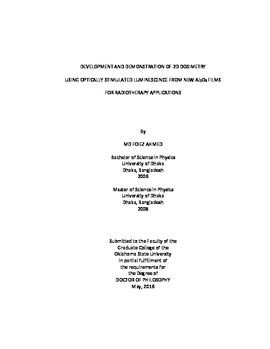| dc.contributor.advisor | Yukihara, Eduardo G. | |
| dc.contributor.author | Ahmed, Md Foiez | |
| dc.date.accessioned | 2017-02-22T22:11:49Z | |
| dc.date.available | 2017-02-22T22:11:49Z | |
| dc.date.issued | 2016-05 | |
| dc.identifier.uri | https://hdl.handle.net/11244/48932 | |
| dc.description.abstract | Scope and Method of Study: The goal of this work was to develop and demonstrate a 2D dosimetry system based on the optically stimulated luminescence (OSL) from new Al2O3 films for radiotherapy applications. A 2D laser-scanning system was developed for the readout and two OSL films (Al2O3:C and Al2O3:C,Mg) were tested. A dose reconstruction algorithm addressing corrections required for the characteristic material properties and the properties related to the system design was developed. The dosimetric properties of the system were tested using clinical X-ray (6 MV) beam. The feasibility of small field dosimetry was tested using heavy ion beams (221 MeV proton and 430 MeV 12C beam). For comparison, clinical tests were performed with ionization chamber, diode arrays and the commercial radiochromic films (Gafchromic EBT3) when applicable. | |
| dc.description.abstract | Findings and Conclusions: The results demonstrate that the developed image reconstruction algorithm enabled > 300x faster laser-scanning readout of the Al2O3 films, eliminating the restriction imposed by its slow luminescence decay. The algorithm facilitates submillimeter spatial resolution, reduces the scanner position dependence (of light collection efficiency) and removes the inherent galvo geometric distortion, among other corrections. The system has a background signal < 1 mGy, linearity correction factor of < 10% up to ~4.0 Gy and < 2% dose uncertainty over the clinically relevant dose range of 0.1 - 30 Gy. The system has a dynamic range of 4 - 5 orders, only limited by PMT linearity. The absolute response from Al2O2:C films is higher than Al2O2:C,Mg films, but with lower image signal-to-noise ratio due to lower concentration of fast F+-center emission. As a result, Al2O2:C,Mg films are better suited than Al2O3:C films for small field dosimetry, which requires precise dosimetry with sub-millimeter spatial resolution. The dose uncertainty associated with OSL film dosimetry is lower than that associated with EBT3 film dosimetry due to lower background, simpler calibration and wider dynamic range. In conclusion, this work demonstrates excellent potentials of the 2D OSL dosimetry system for both relative and absolute dosimetry in radiotherapy applications, with especial emphasis on small fields. | |
| dc.format | application/pdf | |
| dc.language | en_US | |
| dc.rights | Copyright is held by the author who has granted the Oklahoma State University Library the non-exclusive right to share this material in its institutional repository. Contact Digital Library Services at lib-dls@okstate.edu or 405-744-9161 for the permission policy on the use, reproduction or distribution of this material. | |
| dc.title | Development and demonstration of 2D dosimetry using optically stimulated luminescence from new Al2O3 films for radiotherapy applications | |
| dc.contributor.committeeMember | Mintmire, John | |
| dc.contributor.committeeMember | Akselrod, Mark S. | |
| dc.contributor.committeeMember | Ahmad, Salahuddin | |
| dc.contributor.committeeMember | Piao, Daqing (Daching) | |
| osu.filename | Ahmed_okstate_0664D_14495.pdf | |
| osu.accesstype | Open Access | |
| dc.type.genre | Dissertation | |
| dc.type.material | Text | |
| thesis.degree.discipline | Photonics | |
| thesis.degree.grantor | Oklahoma State University | |
